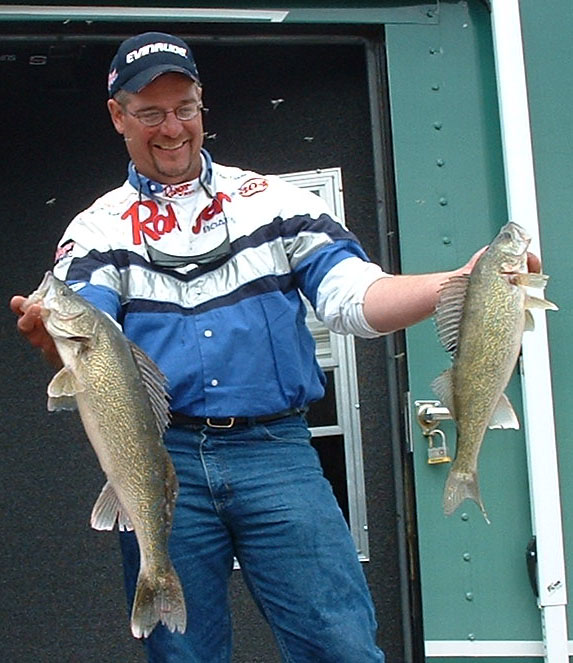Ask the Walleye Pro: Nick Johnson

Q: I have friends that use drift socks when fishing walleyes on large lakes. I don’t know how or when to use them. All I know is that they are for boat control, but beyond that I am clueless. Please help me understand their use.
– Shane Mocks, Grand Rapids, Minn.
A: Shane, a drift sock is a device used to slow down the speed that your boat is drifting with the wind. They are a cone-shaped device that you tie directly to your boat and drag in the water a short distance (usually 10 feet or less) from your boat to slow your drift. The main reason for using a drift sock is to control the drift speed of your boat on a breezy day.
Many times walleyes are scattered over a large flat, and drifting while dragging a jig or a crawler harness will produce many fish. Occasionally the wind will drift your boat over the fish too fast and will not allow your presentation to stay in the strike zone long enough to get bit. The solution to this predicament is to deploy a drift sock (or two). If you tie off the sock near the back of your boat, you will drift with the waves pushing into the transom. Exactly the opposite will occur if you tie your sock to the bow. If you tie one sock to the bow and one near the transom, you will drift broadside with the waves allowing everyone in the boat a tangle-free presentation.
Many companies make drift socks. I prefer Minn Kota’s version featuring rip-stop nylon that is very durable and dries quickly to avoid mold when stored.
Q: I have seen some giant walleyes caught from Lake Erie. What do you think are the best tactics for bringing in those monsters?
– Mike Writts, Sandusky, Ohio
A: Mike, as with any fish, to be successful it is important to understand seasonal migrations. In the spring of the year when water temperatures near 35 to 45 degrees, walleyes will begin to stage near spawning areas. In Lake Erie, these areas consist of shallow reefs and in, or near, the many rivers that flow into the lake (specifically the shallow western basin). At this time, vertical jigging or casting a Lindy Fuzzy Grub Jig tipped with a minnow is a very productive technique.
When the walleyes finish spawning, they begin a slow migration eastward toward deeper water, following suspended baitfish. One of my favorite techniques for catching these fish is using a spinner/night-crawler harness combined with snap weights pulled behind an Off Shore planer board. Another proven favorite is a crankbait like the Rapala Deep Husky Jerk or an 800 series deep-diving Reef Runner trolled behind an Off Shore planer board.
Always experiment with the depth of your presentation, which is basically governed by the amount of line out behind the board for crankbaits, or the size of the snap weight versus the amount of line out for spinner rigs. This concept is explained superbly in “The Trollers Bible: Precision Trolling, 7th Edition” by Dr. Steven Holt, Mark Romanack and Tom Irwin.
Q: I was at the landing once last year and heard some guys talking about walleye chop. I’m not sure, but I assume walleye chop is when the lake is a little choppy. Why do walleyes bite better when the water is choppy? Are there certain tactics to be used when that is the case?
– Ken Johnson, Fort Dodge, Iowa
A: Ken, any condition that breaks the mirror surface of the water (usually wind, but sometimes consistent boat traffic) can be considered a “walleye chop.” There are two main reasons walleyes bite better in this situation. When the surface water is choppy, it cuts down immensely on the amount of light that penetrates the water. Walleyes will take advantage of this situation and use their excellent low-light vision to stalk schools of vulnerable baitfish. The second situation is directly related to wind blowing the waves into shallow water and shoreline areas. This creates many opportunities for walleyes to feed by stirring up sediment and dislodging minnows, crayfish or other potential prey.
I like to fish shallow-water locations such as points and steep, rocky shorelines when there is a good walleye chop blowing. Some of my favorite techniques include casting crankbaits or jigs to these fish. Remember, the walleyes have moved shallow specifically to feed and they are usually aggressive. I like to cast crankbaits until I catch a fish or two from a specific area. I’ll then rework the area with a jig and live bait to pick off a few more fish.
Nick Johnson is the reigning walleye king after claiming the 2004 Wal-Mart RCL Walleye Championship on the Mississippi River. Johnson earned $300,000 for his victory, which was the largest first-place award in walleye tournament fishing. For his career, Johnson has finished in the top 10 four times. In addition to fishing professionally on the Wal-Mart FLW Walleye Tour, the Elmwood, Wis., native attends classes at Chippewa Valley Technical College in Menomonie, Wis. Johnson’s sponsors include Ranger Boats, Evinrude and Minn Kota.